Effect of Seawater and Fly Ash Contaminants on Insulator Surfaces Made of Polymer Based on Finite Element Method
Abstract
:1. Introduction
2. Research Description
2.1. Equivalent Salt Density Deposit (ESDD)
2.2. Nonsoluble Deposit Density (NSDD)
2.3. Leakage Current
3. Experimental Setup
3.1. Modeling and Determination of Simulation Parameters
3.2. Finite Element Method (FEM)
3.3. Calculation of Insulator Surface Area
3.4. ESDD Insulator Pollution Level Calculation
3.5. NSDD Pollution Level Calculation
3.6. Natural Aging Insulator
3.7. Insulator Testing Scheme
4. Result and Data Analysis
4.1. Polymer Insulator Simulation Results
4.1.1. Voltage Distribution in Polymer Insulators
4.1.2. Effect of Contaminants on Electric Field
4.1.3. Effect of Contaminants on Current Density
4.1.4. Effect of Electrical Conductivity on Leakage Current
4.2. Polymer Insulator Experiment Results
4.2.1. Comparison of Leakage Current of Aging with Aging Insulator
4.2.2. Comparison of Dry Insulator Leakage Current with Wet Insulator
4.2.3. Comparison of the Change in Voltage to the Leakage Current in the Insulator
4.2.4. Comparison of the Effect of ESDD and NSDD on Leakage Current in the Insulator
4.3. Comparison of Simulation Results with Testing
4.3.1. Comparison on Seawater Contaminants
4.3.2. Comparison of Fly Ash Contaminants
5. Conclusions
Author Contributions
Funding
Institutional Review Board Statement
Informed Consent Statement
Data Availability Statement
Conflicts of Interest
References
- Tobing, B.L. High Voltage Equipment; Erlangga: Jakarta, Indonesia, 2012. [Google Scholar]
- Gutman, I.; Dernfalk, A. Pollution tests for polymeric insulators made of hydrophobicity transfer materials. IEEE Trans. Dielectr. Electr. Insul. 2010, 17, 384–393. [Google Scholar] [CrossRef]
- Cho, H.G.; Han, S.W.; Lee, U.Y. Multi-Aging Test Technology for Estimating Long Time Performance of Polymer Insulators. In Proceedings of the IEEE International Symposium on Electrical Insulation, Boston, MA, USA, 7–10 April 2002; pp. 232–236. [Google Scholar]
- Sinaga, J.J.; Zega, S. Study of the Effect of Air Pollution Contamination on a 20 Kv Medium Voltage Insulator at PT PLN (Persero) Customer Service Implementing Unit (UP3) Medan. J. Teknol. Energy Uda 2020, 9, 31–43. [Google Scholar]
- Uydur, C.C.; Arikan, O.; Kalenderli, O. The Effect of Insulation Defects on Electric Field Distribution of Power Cables. In Proceedings of the 2018 IEEE International Conference on High Voltage Engineering and Application (ICHVE), Athens, Greece, 10–13 September 2018; pp. 1–4. [Google Scholar]
- Hussain, M.; Mcmeekin, S.; Farzaneh, M.; Farokhi, S. The Effects of Salt Contamination Deposition on HV Insulators Under Environmental Stresses. In Proceedings of the 11th International Conference on the Properties and Applications of Dielectric Materials (ICPADM), Sydney, Australia, 19–22 July 2015. [Google Scholar]
- Santosa, D.H. Analysis of the Accelerated Age of Ceramic Insulators in 20 Kv Distribution Channels in Coastal Areas Due to Air Contaminants; Sepuluh Nopember Institute of Technology: Surabaya, Indonesia, 2017. [Google Scholar]
- Subekti, S. Analysis of the Proportion of Fly Ash Paiton and Tjiwi Kimia Waste Against Compressive Strength of Geopolymer Paste. In Proceedings of the Prosiding Seminar Nasional Aplikasi Teknologi Prasarana Wilayah (ATPW), Surabaya, Indonesia, 11 July 2012; Available online: https://dokumen.tips/documents/analisa-proporsi-limbah-fly-ash-paiton-dan-tjiwi-kimia.html (accessed on 1 November 2021).
- Ilhan, S.; Cherney, E.A. Comparative tests on RTV silicone rubber coated porcelain suspension insulators in a salt-fog chamber. IEEE Trans. Dielectr. Electr. Insul. 2018, 25, 947–953. [Google Scholar] [CrossRef]
- Nekahi, A.; McMeekin, S.G.; Farzaneh, M. Effect of pollution severity on electric field distribution along a polymeric insulator. In Proceedings of the 2015 IEEE 11th International Conference on the Properties and Applications of Dielectric Materials (ICPADM), Sydney, NSW, Australia, 19–22 July 2015; pp. 612–615. [Google Scholar]
- Khare, T.; Hasabe, R.; Mandlik, M. Electric Field and Potential Distribution along Porcelain Insulator under Polluted Conditions using Finite Element Method. Int. J. Adv. Res. Electr. Electron. Instrum. Eng. 2016, 5, 3531–3536. [Google Scholar]
- Othman, N.A.; Piah, M.A.M.; Adzis, Z.; Ahmad, H.; Ahmad, N.A. Simulation of voltage and electric-field distribution for contaminated glass insulator. In Proceedings of the 2013 IEEE Student Conference on Research and Development, Putrajaya, Malaysia, 16–17 December 2013; pp. 116–120. [Google Scholar]
- Gustavsson, T.G.; Gubanski, S.M.; Hillborg, H.; Karlsson, S.; Gedde, U.W. Aging of silicone rubber under ac or dc voltages in a coastal environment. IEEE Trans. Dielectr. Electr. Insul. 2001, 8, 1029–1039. [Google Scholar] [CrossRef]
- Fahmi, D.; Negara, I.M.Y.; Asfani, D.A.; Afif, Y. Electric Field Distribution Analysis on Hanging Insulator Types of Polymers due to the Effect of Contaminants. Natl. J. Electr. Eng. 2015, 4. [Google Scholar] [CrossRef] [Green Version]
- Yu, Z.; Peng, Z.; Liu, P.; Wu, X. The influence of charged sand particles on the external insulation performance of composite insulators in sandstorm condition. In Proceedings of the 2006 IEEE 8th International Conference on Properties & Applications of Dielectric Materials, Bali, Indonesia, 26–30 June 2006; pp. 542–545. [Google Scholar]
- Sunitha, N.S.; Ravi, K.N.; Prakash, R. A study on leakage current characteristics of polymeric insulators for different pollution layers. In Proceedings of the 2015 International Conference on Power and Advanced Control Engineering (ICPACE), Bengaluru, India, 12–14 August 2015; pp. 383–387. [Google Scholar]
- Dhofir, M.; Andaru, D.D.; Hasanah, R.N. The influence of conduction band location on the leakage current level of a glass insulator. In Proceedings of the 2017 5th International Conference on Electrical, Electronics and Information Engineering (ICEEIE), Malang, Indonesia, 6–8 October 2017; pp. 25–31. [Google Scholar]
- Hussain, M.M.; Farokhi, S.; McMeekin, S.G.; Farzaneh, M. Effect of cold fog on leakage current characteristics of polluted insulators. In Proceedings of the 2015 International Conference on Condition Assessment Techniques in Electrical Systems (CATCON), Bangalore, India, 10–12 December 2015; pp. 163–167. [Google Scholar]
- El-Hag, A.H. Promoting condition monitoring and diagnostics of electrical insulation in undergraduate capstone graduation projects. IEEE Electr. Insul. Mag. 2015, 31, 8–15. [Google Scholar] [CrossRef]
- Muniraj, C.; Chandrasekar, S. Finite Element Modeling for Electric Field and Voltage Distribution along the Polluted Polymeric Insulator. World J. Modeling Simul. 2012, 8, 310–320. [Google Scholar]
- Bojovschi, A.; Quoc, T.V.; Trung, H.N.; Quang, D.T.; Le, T.C. Environmental Effects on HV Dielectric Materials and Related Sensing Technologies. Appl. Sci. 2019, 9, 856. [Google Scholar] [CrossRef] [Green Version]
- Akbar, M.; Ullah, R.; Alam, S. Aging of Silicone Rubber-based Composite Insulators under Multi-stressed Conditions. Mater. Res. Express 2019, 6, 102003. [Google Scholar] [CrossRef]
- Gorur, R.S.; Montesinos, J.; Roberson, R.; Burnham, J.; Hill, R. Mold growth on nonceramic insulators and its impact on electrical performance. IEEE Trans. Power Deliv. 2003, 18, 559–563. [Google Scholar] [CrossRef]
- Ghosh, D.; Khastgir, D. Degradation and Stability of Polymeric High-Voltage Insulators and Prediction of Their Service Life through Environmental and Accelerated Aging Processes. ACS Omega 2018, 3, 11317–11330. [Google Scholar] [CrossRef] [PubMed]
- Wang, J.; Gubanski, S.M.; Blennow, J.; Atarijabarzadeh, S.; Stromberg, E.; Karlsson, S. Influence of biofilm contamination on electrical performance of silicone rubber based composite materials. IEEE Trans. Dielectr. Electr. Insul. 2012, 19, 1690–1699. [Google Scholar] [CrossRef]
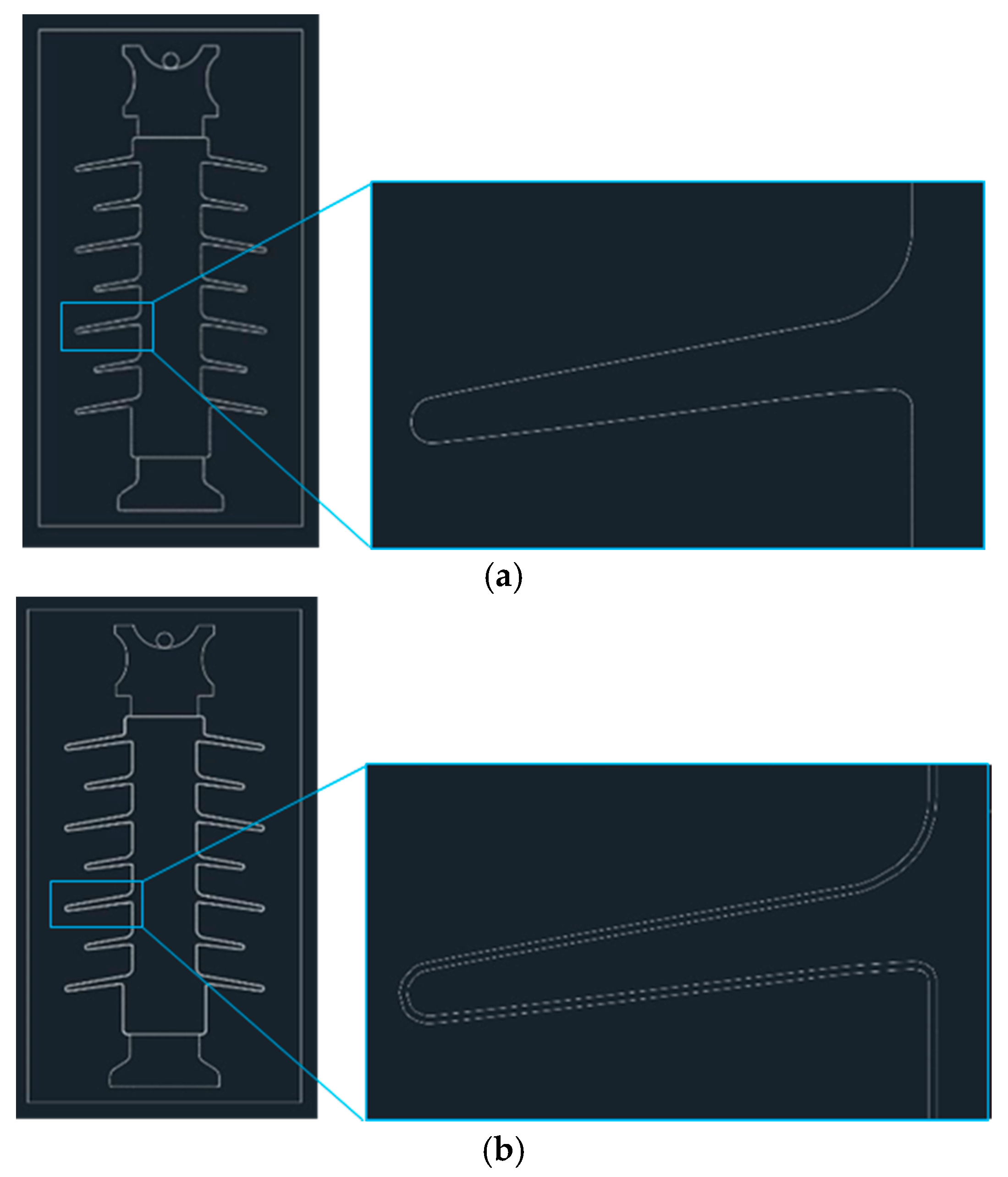
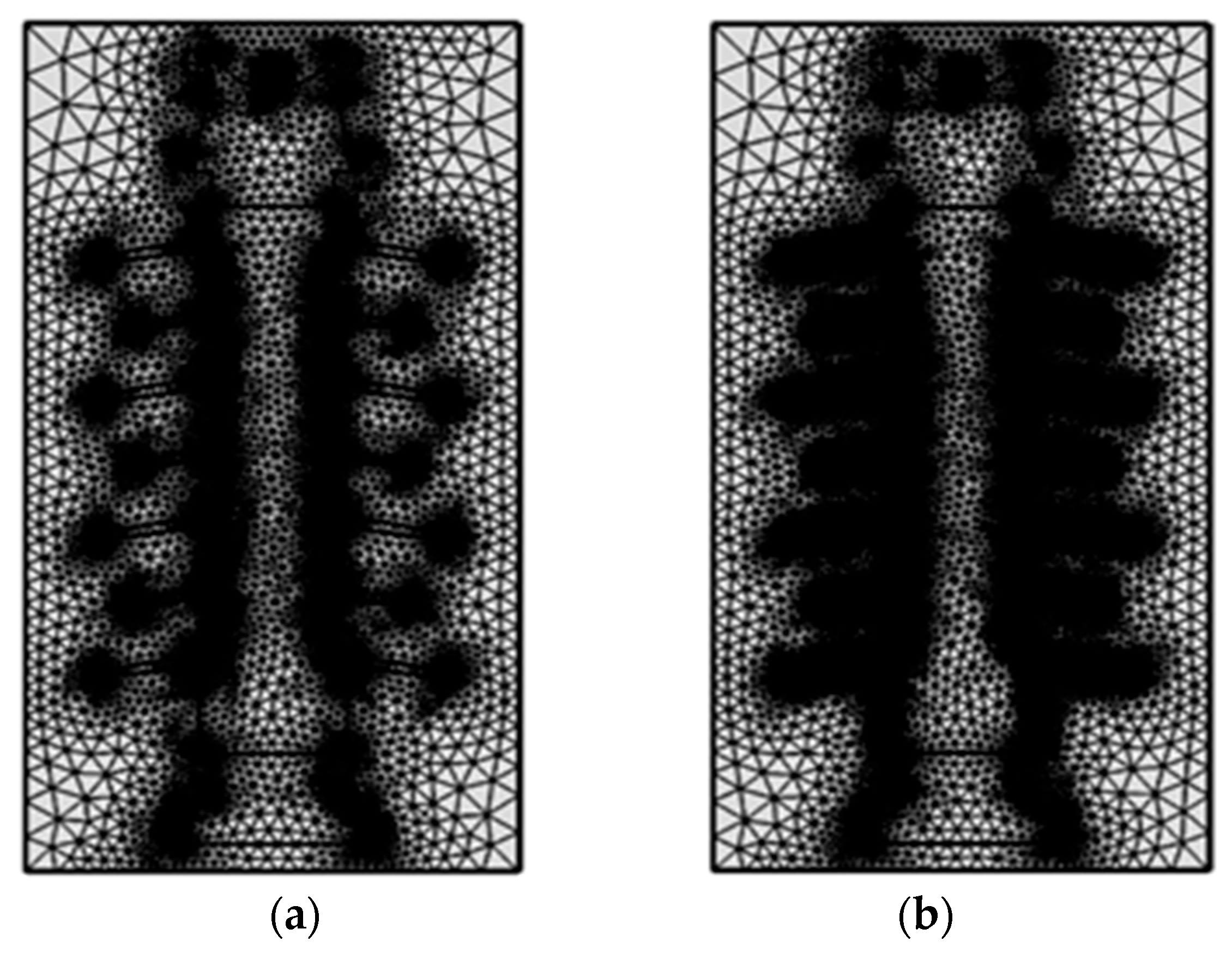



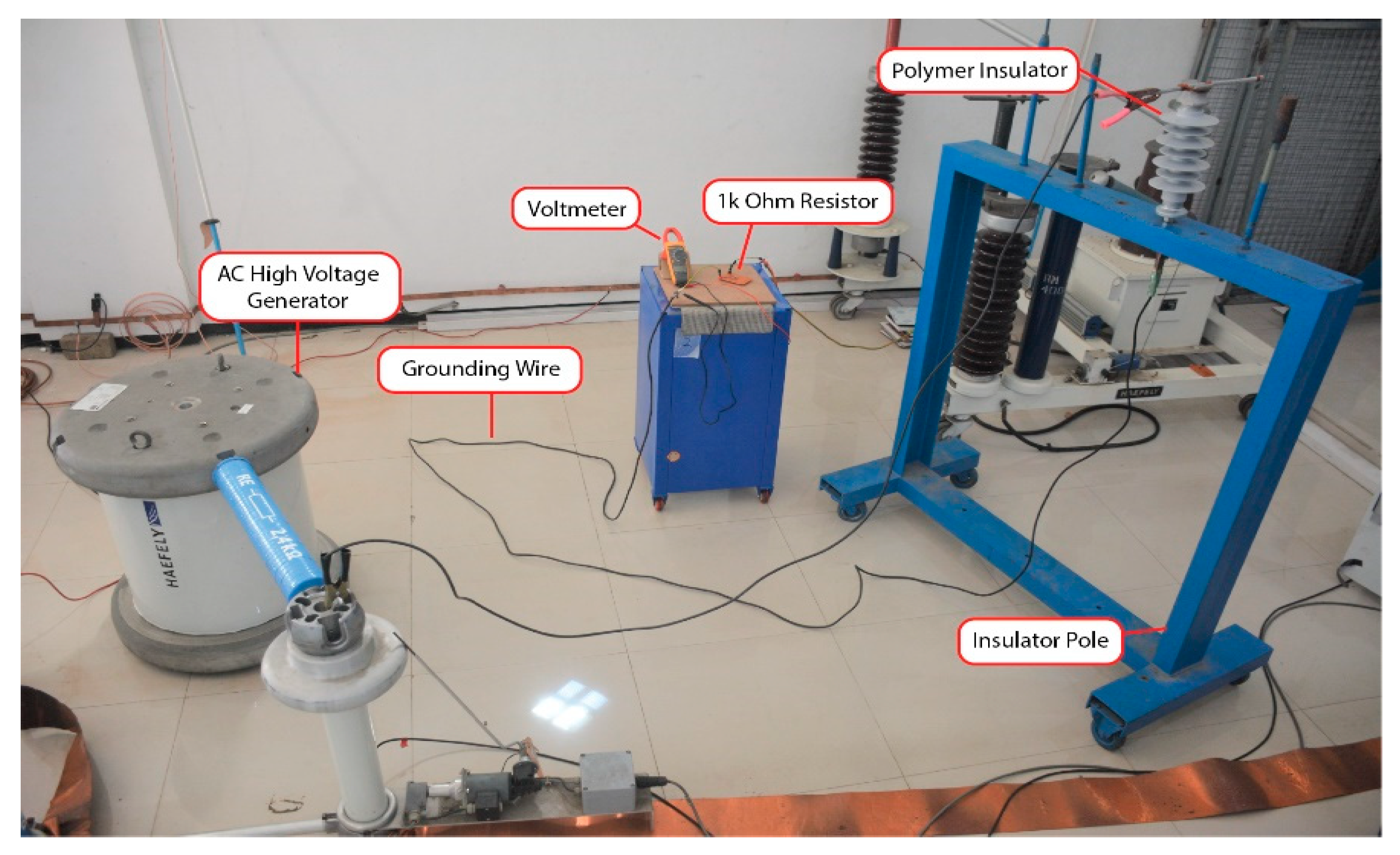
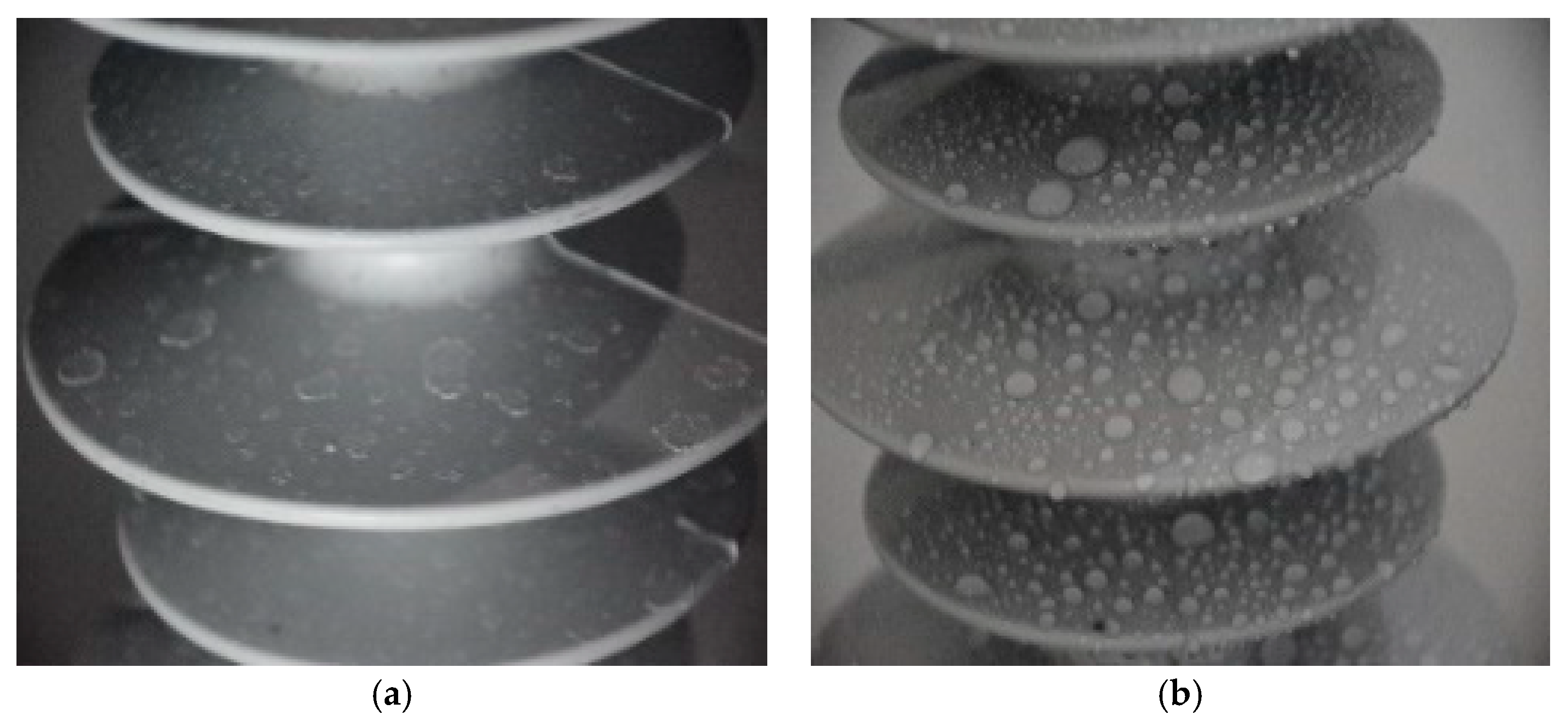






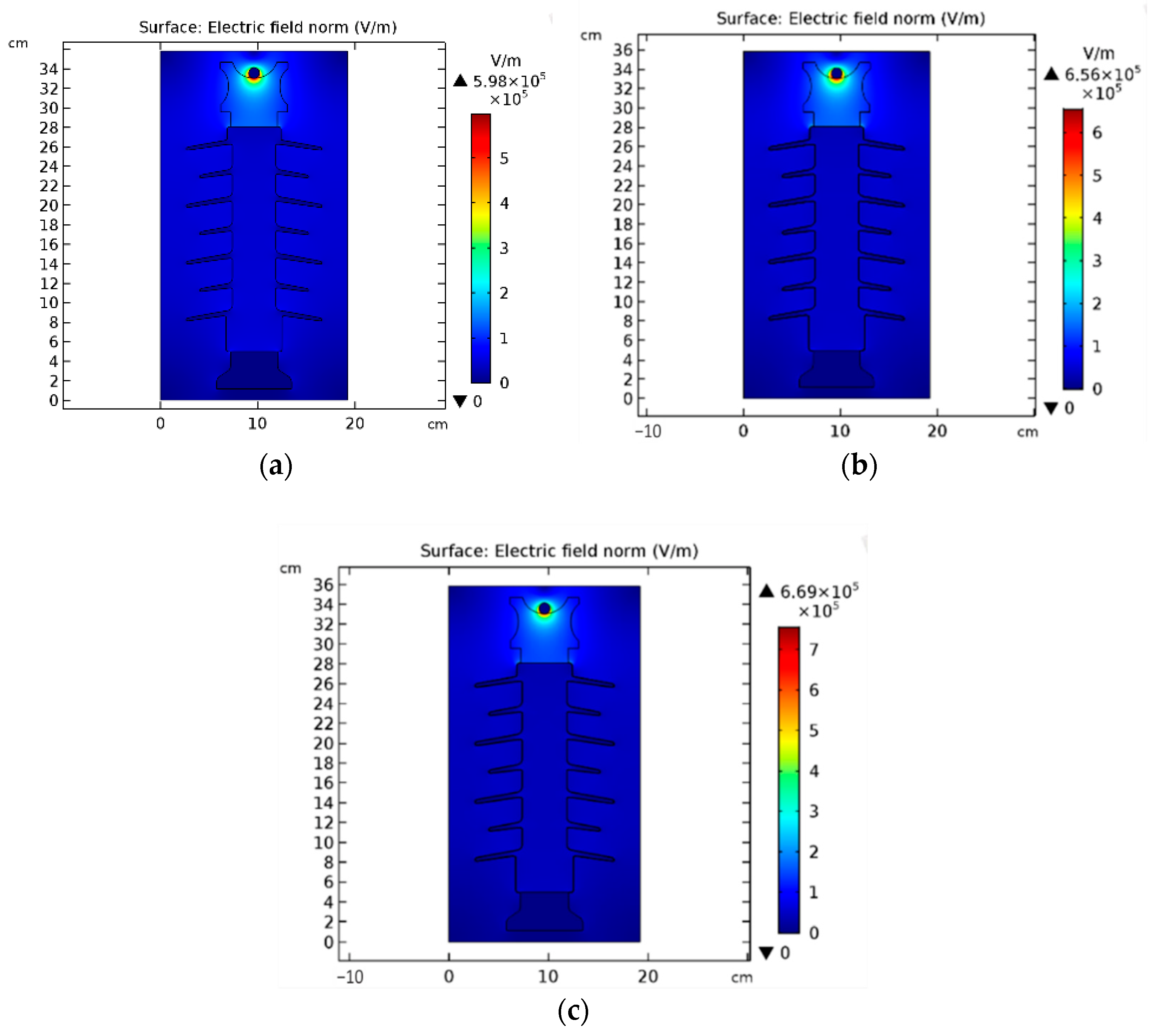
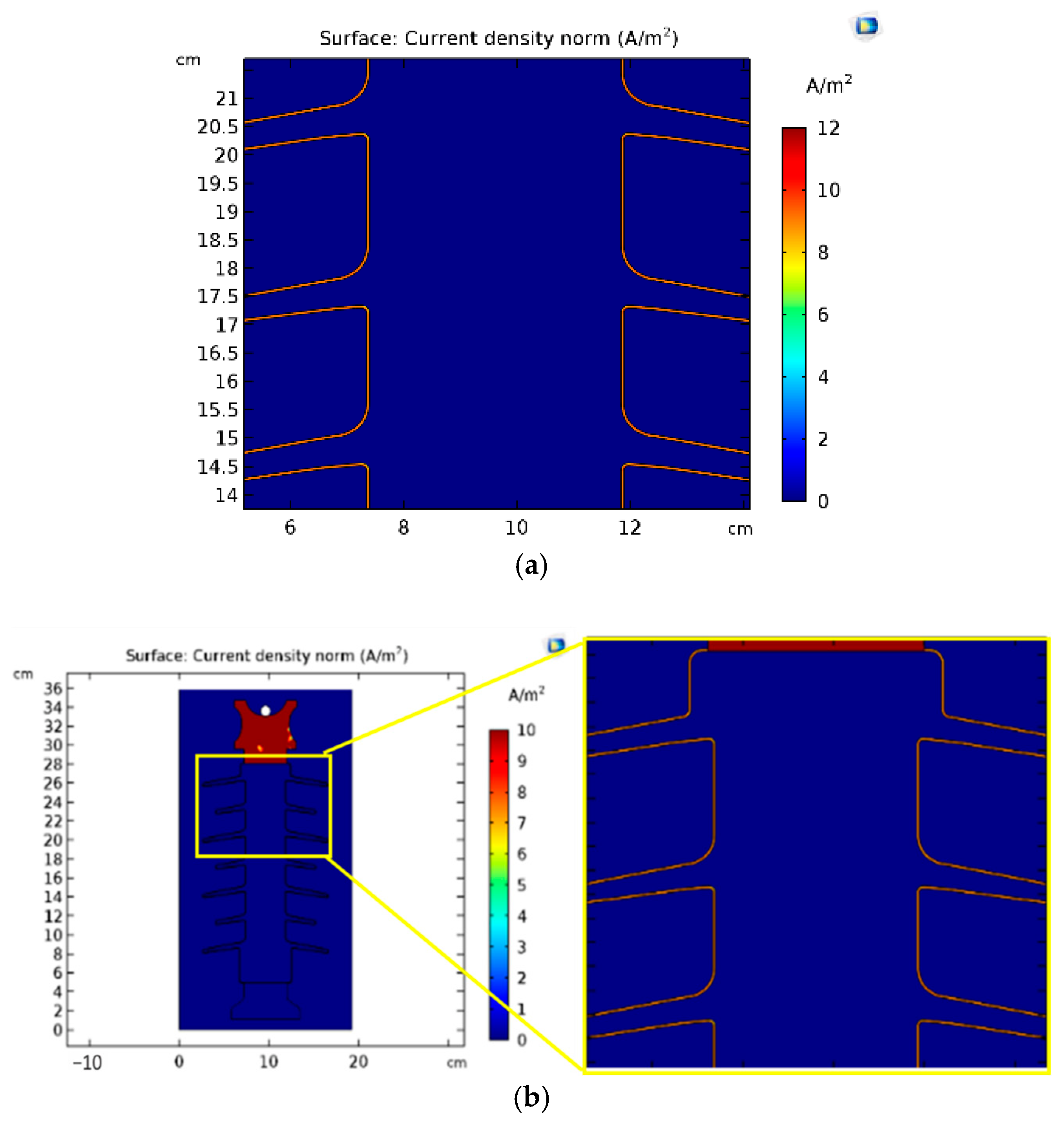
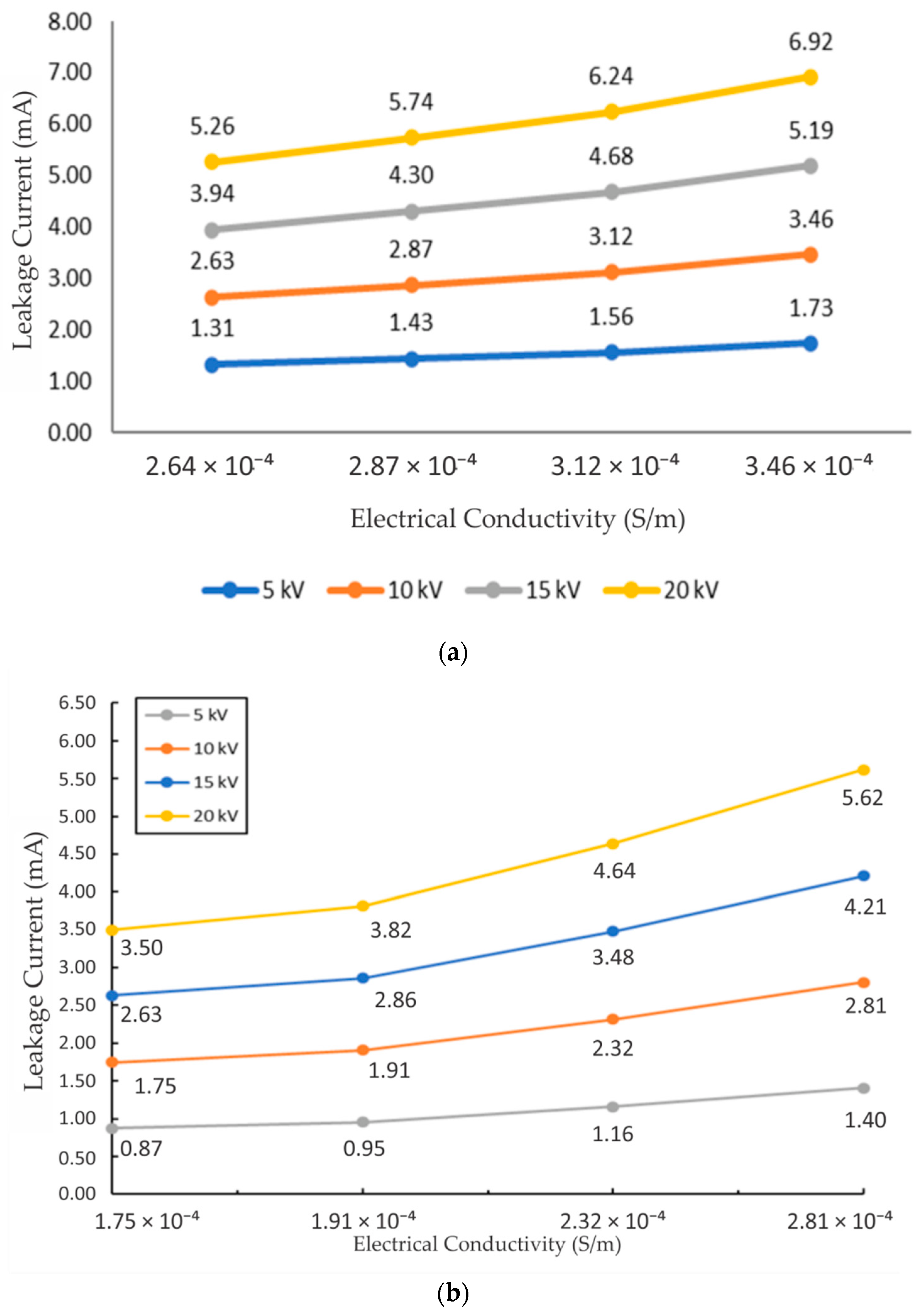

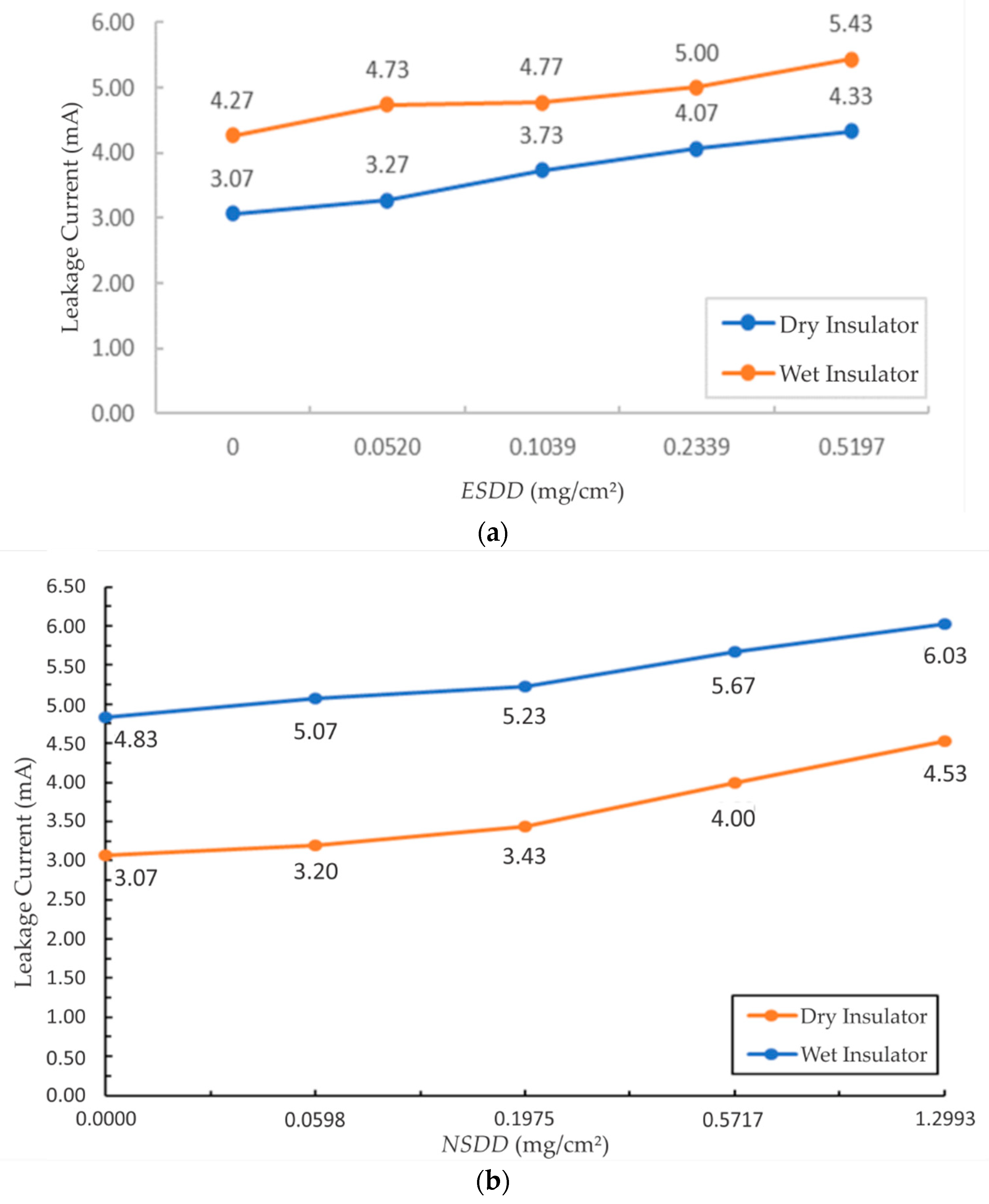

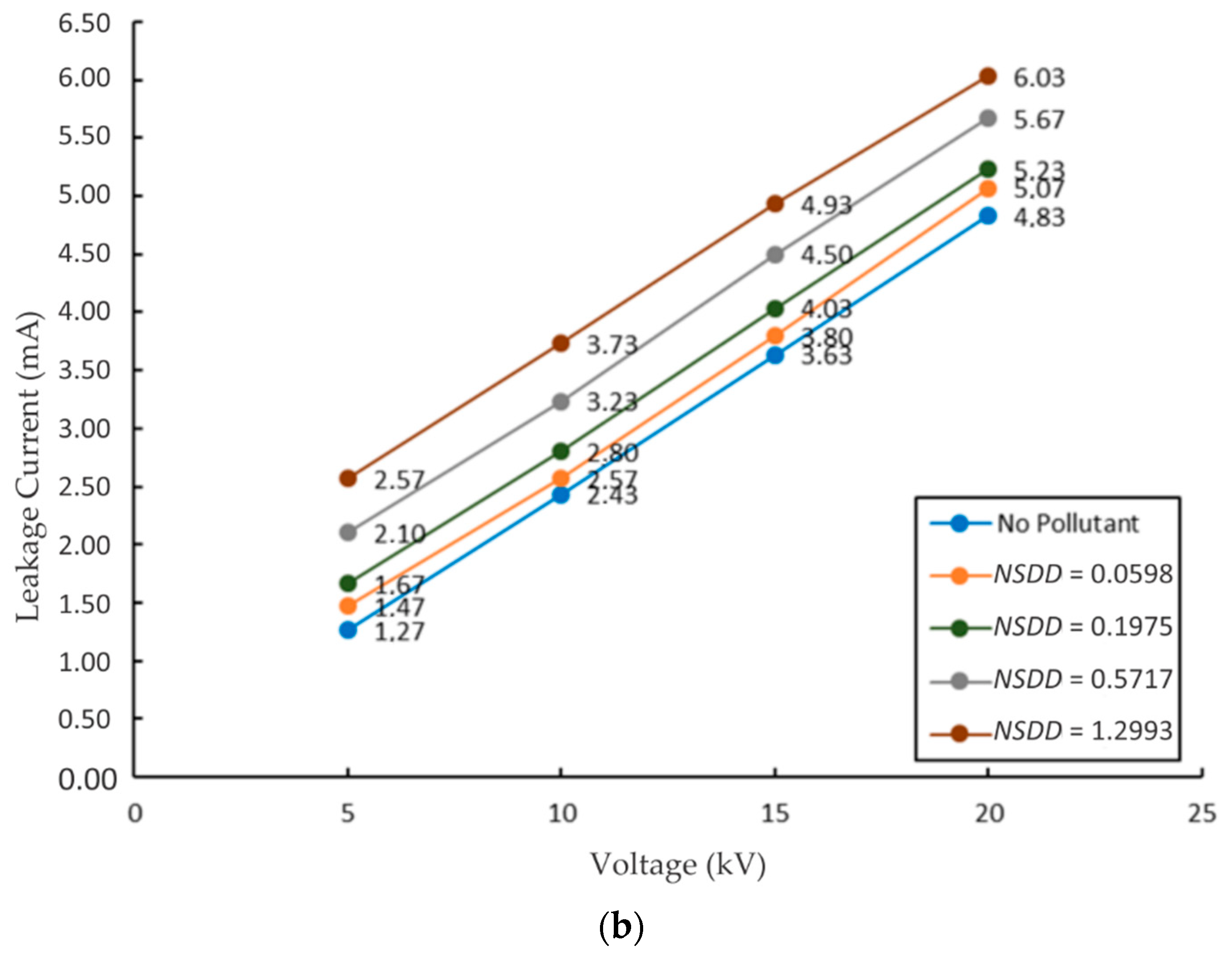



| Pollution Level | ESDD (mg/cm2) | NSDD (mg/cm2) |
|---|---|---|
| Light | <0.06 | 0.03–0.06 |
| Currently | 0.06–0.12 | 0.10–0.20 |
| Heavy | 0.12–0.24 | 0.30–0.60 |
| Very heavy | >0.24 | >0.80 |
| Material | Relative Permittivity r | Electrical Conductivity (S/m) |
|---|---|---|
| Polymer | 4.3 | 1 × 10−13 |
| Air | 1 | 1 × 10−14 |
| Steel | 1 | 5.9 × 107 |
| Aluminum | 2.2 | 3.69 × 107 |
| Salt contaminants | 80 | Varies |
| Fly ash | 104 | Varies |
| Salination (g/L) | ESDD (mg/cm2) | Electrical Conductivity (S/m) | Information |
|---|---|---|---|
| 2 | 0.0520 | 2.64 × 10−4 | Light |
| 4 | 0.1039 | 2.87 × 10−4 | Currently |
| 9 | 0.2339 | 3.12 × 10−4 | Heavy |
| 20 | 0.51997 | 3.46 × 10−4 | Very heavy |
| Pollutant Mass (mg) | NSDD (mg/cm2) | Electrical Conductivity (S/m) | Pollution Level |
|---|---|---|---|
| 115 | 0.0598 | 1.75 × 10−4 | Light |
| 380 | 0.1975 | 1.91 × 10−4 | Currently |
| 1100 | 0.5717 | 2.32 × 10−4 | Heavy |
| 2500 | 1.2993 | 2.81 × 10−4 | Very heavy |
Publisher’s Note: MDPI stays neutral with regard to jurisdictional claims in published maps and institutional affiliations. |
© 2021 by the authors. Licensee MDPI, Basel, Switzerland. This article is an open access article distributed under the terms and conditions of the Creative Commons Attribution (CC BY) license (https://creativecommons.org/licenses/by/4.0/).
Share and Cite
Negara, I.M.Y.; Hernanda, I.G.N.S.; Asfani, D.A.; Wardani, M.K.; Yegar, B.K.; Syahril, R. Effect of Seawater and Fly Ash Contaminants on Insulator Surfaces Made of Polymer Based on Finite Element Method. Energies 2021, 14, 8581. https://doi.org/10.3390/en14248581
Negara IMY, Hernanda IGNS, Asfani DA, Wardani MK, Yegar BK, Syahril R. Effect of Seawater and Fly Ash Contaminants on Insulator Surfaces Made of Polymer Based on Finite Element Method. Energies. 2021; 14(24):8581. https://doi.org/10.3390/en14248581
Chicago/Turabian StyleNegara, I Made Yulistya, I. G. N. Satriyadi Hernanda, Dimas Anton Asfani, Mira Kusuma Wardani, Bonifacius Kevin Yegar, and Reynaldi Syahril. 2021. "Effect of Seawater and Fly Ash Contaminants on Insulator Surfaces Made of Polymer Based on Finite Element Method" Energies 14, no. 24: 8581. https://doi.org/10.3390/en14248581
APA StyleNegara, I. M. Y., Hernanda, I. G. N. S., Asfani, D. A., Wardani, M. K., Yegar, B. K., & Syahril, R. (2021). Effect of Seawater and Fly Ash Contaminants on Insulator Surfaces Made of Polymer Based on Finite Element Method. Energies, 14(24), 8581. https://doi.org/10.3390/en14248581






